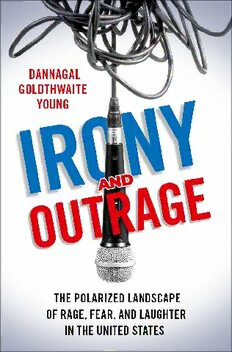
Irony and Outrage: The Polarized Landscape of Rage, Fear, and Laughter in the United States PDF
Preview Irony and Outrage: The Polarized Landscape of Rage, Fear, and Laughter in the United States
Irony and Outrage Irony and Outrage The Polarized Landscape of Rage, Fear, and Laughter in the United States DANNAGAL GOLDTHWAITE YOUNG 1 1 Oxford University Press is a department of the University of Oxford. It furthers the University’s objective of excellence in research, scholarship, and education by publishing worldwide. Oxford is a registered trade mark of Oxford University Press in the UK and certain other countries. Published in the United States of America by Oxford University Press 198 Madison Avenue, New York, NY 10016, United States of America. © Oxford University Press 2020 All rights reserved. No part of this publication may be reproduced, stored in a retrieval system, or transmitted, in any form or by any means, without the prior permission in writing of Oxford University Press, or as expressly permitted by law, by license, or under terms agreed with the appropriate reproduction rights organization. Inquiries concerning reproduction outside the scope of the above should be sent to the Rights Department, Oxford University Press, at the address above. You must not circulate this work in any other form and you must impose this same condition on any acquirer. Library of Congress Cataloging-in-Publication Data Names: Young, Dannagal G., author. Title: Irony and outrage : the polarized landscape of rage, fear, and laughter in the United States / Dannagal Goldthwaite Young. Description: New York, NY, United States of America : Oxford University Press, [2020] | Includes bibliographical references and index. Identifiers: LCCN 2019006859 (print) | LCCN 2019980569 (ebook) | ISBN 9780190913083 (hardcover : acid-free paper) | ISBN 9780190913106 (ebook) | ISBN 9780190913090 (pdf) Subjects: LCSH: Mass media—Political aspects—United States. | Mass media and public opinion—United States. | Television talk shows—Political aspects—United States. | Radio talk shows—Political aspects—United States. | Television in politics—United States. | Radio in politics—United States. | Right and left (Political science)—United States. | Political culture—United States. | Political satire, American. Classification: LCC P95.82.U6 Y68 2020 (print) | LCC P95.82.U6 (ebook) | DDC 810.9/93581—dc23 LC record available at https://lccn.loc.gov/2019006859 LC ebook record available at https://lccn.loc.gov/2019980569 9 8 7 6 5 4 3 2 1 Printed by Sheridan Books, Inc., United States of America For Mike Young, whose infinite tolerance for ambiguity taught me to be comfortable in the not-knowing. For Michelle Kennedy, whose high need for closure taught me to stop thinking and just do something goddammit. Contents Acknowledgments ix Prologue 1 1. The Counterculture Comics versus the Hate Clubs of the Air 8 2. P olitical and Technological Changes That Created Jon Stewart and Bill O’Reilly 32 3. Outrage and Satire as Responses and Antidotes 48 4. The Psychology of Satire 69 5. Who Gets the Joke? 85 6. The Psychology of the Left and the Right 100 7. The Psychological Roots of Humor’s Liberal Bias 119 8. The Aesthetics of Outrage 141 9. Satire and Outrage: Parallel Functions and Impact 168 10. P laying against Type: Liberal “Outrage” and Conservative “Satire” 192 11. I rony and Outrage: A Wild Raccoon versus a Well-Trained Attack Dog 207 Notes 215 Index 255 Acknowledgments countless friends and mentors made me feel that this project was worth pursuing and that I was the person to do it: Regina Lawrence, whose tireless mentoring and praise of my ideas convinced me that I know what I’m talking about; Sarah Sobieraj, who thinks and talks and brainstorms like an improviser in the best of all possible ways: “yes anding,” building on offers to help you complete the scene—and the book. Michael Delli Carpini, who was excited about this idea from the start, and generously read a very early first draft, offering suggestions of where to tighten up the narrative. Lance Holbert, who has always been a champion of me and my work, even back when there wasn’t very much work to be a champion of. My supportive colleagues and friends at the University of Delaware, with whom I’ve discussed these ideas (way too much) over the years; especially Scott Caplan, Lindsay Hoffman, Jenny Lambe, Paul Brewer, Steve Mortensen, Lydia Timmins, Tracey Holden, Phil Jones, Joanne Miller, Dave Redlawsk, Nancy Signorielli, John Courtright, Betsy Perse, and Kami Silk. My mentors from the Annenberg School for Communication at the University of Pennsylvania, including MXD, Joe Cappella, and Kathleen Hall Jamieson (who gave me invaluable publishing advice) and the brilliant Annenberg crew of the early 2000s, who inspire me every day: especially Kate Kenski, Jenny Stromer-Galley, Matt Carlson, Brooke Duffy, Jeff Gottfried, Talia Stroud, Scott Stroud, and Tresa Undem. The extraordinary women of political communication and political science (#wom- enalsoknowstuff), who are at once friends and colleagues: Amber Boydstun, Shannon McGregor, Katie Searles, and Jess Feezell. For their generosity in taking the time to be interviewed, I would like to extend my heartfelt gratitude to The Committee’s Alan Myerson, Ed Greenberg, and Latifah Taormina, comedy writer David Misch, documentary filmmaker Sam Shaw, and comedian Frank Lesser. Thank you especially to Full Frontal’s Ashley Black for entertaining these heady questions while still
